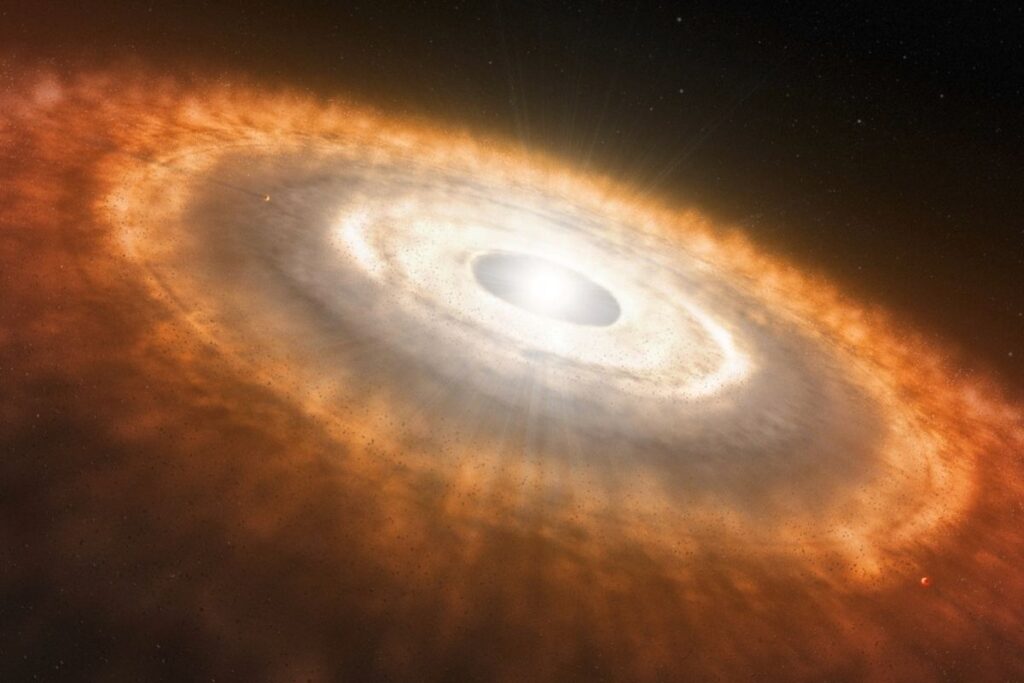NASA’s James Webb Space Telescope (JWST) has obtained the first-ever observation of a planetary disk’s inner, radiation-soaked region where rocky planets take shape. Notably, it identified the presence of water and diverse molecules within this inner region, indicating the potential for terrestrial planets to form in extreme environments. A multinational team of scientists analyzed planet-forming discs in the Lobster Nebula, also known as NGC 6357, which is some 5,500 light-years away from Earth.
“Webb is the only telescope with the spatial resolution and sensitivity to study planet-forming disks in massive star-forming regions,” said team lead María Claudia Ramírez-Tannus of the Max Planck Institute for Astronomy in Germany, in an Detection of various molecules despite intense radiation Webb’s Mid-Infrared Instrument (MIRI) was used by astronomers to study the protoplanetary disk XUE 1 in the star cluster Pismis 24. This tool was critical in acquiring data on the disk’s physical properties and chemical makeup. “Only the MIRI wavelength range and spectral resolution allow us to probe the molecular inventory and physical conditions of the warm gas and dust where rocky planets form,” said Arjan Bik of Stockholm University in Sweden.
During the observations of XUE 1, researchers expected it to be bathed in ultraviolet radiation due to the presence of several massive stars in NGC 6357. However, they were surprised to discover a variety of molecules, fundamental to the construction of rocky planets, thriving in such an extreme environment. “We find that the inner disk around XUE 1 is remarkably similar to those in nearby star-forming regions.
We’ve detected water and other molecules like carbon monoxide, carbon dioxide, hydrogen cyanide, and acetylene. However, the emission found was weaker than some models predicted. This might imply a small outer disk radius,” said team member Rens Waters of Radboud University in the Netherlands.
“We were surprised and excited because this is the first time that these molecules have been detected under these extreme conditions,” added Lars Cuijpers of Radboud University. This new study challenges previous theories and suggests that the conditions conducive to the birth of terrestrial planets may be more diverse than previously imagined. The study was part of the eXtreme Ultraviolet Environments (XUE) James Webb Space Telescope program, which is dedicated to exploring planet-forming disks within huge star-forming regions.
The findings were reported in We present the first results of the eXtreme UV Environments (XUE) James Webb Space Telescope (JWST) program, which focuses on the characterization of planet-forming disks in massive star-forming regions. These regions are likely representative of the environment in which most planetary systems formed. Understanding the impact of environment on planet formation is critical in order to gain insights into the diversity of the observed exoplanet populations.
XUE targets 15 disks in three areas of NGC 6357, which hosts numerous massive OB stars, including some of the most massive stars in our Galaxy. Thanks to JWST, we can, for the first time, study the effect of external irradiation on the inner (<10 au), terrestrial-planet-forming regions of protoplanetary disks. In this study, we report on the detection of abundant water, CO, 12CO2, HCN, and C2H2 in the inner few au of XUE 1, a highly irradiated disk in NGC 6357.
In addition, small, partially crystalline silicate dust is present at the disk surface. The derived column densities, the oxygen-dominated gas-phase chemistry, and the presence of silicate dust are surprisingly similar to those found in inner disks located in nearby, relatively isolated low-mass star-forming regions. Our findings imply that the inner regions of highly irradiated disks can retain similar physical and chemical conditions to disks in low-mass star-forming regions, thus broadening the range of environments with similar conditions for inner disk rocky planet formation to the most extreme star-forming regions in our Galaxy.
.
From: interestingengineering
URL: https://interestingengineering.com/science/webb-reveals-rocky-planets-may-form-in-extreme-radiation-environment
